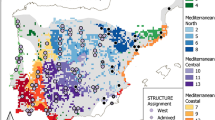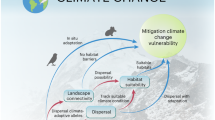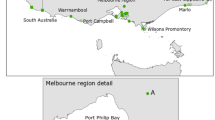Abstract
Many endangered species persist as a series of isolated populations, with some populations more genetically diverse than others. If climate change disproportionately threatens the most diverse populations, the species’ ability to adapt (and hence its long-term viability) may be affected more severely than would be apparent by its numerical reduction. In the present study, we combine genetic data with modelling of species distributions under climate change to document this situation in an endangered lizard (Eulamprus leuraensis) from montane southeastern Australia. The species is known from only about 40 isolated swamps. Genetic diversity of lizard populations is greater in some sites than others, presumably reflecting consistently high habitat suitability over evolutionary time. Species distribution modelling suggests that the most genetically diverse populations are the ones most at risk from climate change, so that global warming will erode the species’ genetic variability faster than it curtails the species’ geographic distribution.




Similar content being viewed by others
References
Araujo MB, Pearson RG (2005) Equilibrium of species’ distributions with climate. Ecography 28:693–695
Araujo MB, Thuiller W, Pearson RG (2006) Climate warming and the decline of amphibians and reptiles in Europe. J Biogeogr 33:1712–1728
Beever EA, Brussard PE, Berger J (2003) Patterns of apparent extirpation among isolated populations of pikas (Ochotona princeps) in the Great Basin. J Mammal 84:37–54
Brown KM, Baltazar GA, Hamilton MB (2005) Reconciling nuclear microsatellite and mitochondrial marker estimates of population structure: breeding population structure of Chesapeake Bay striped bass (Morone saxatilis). Heredity 94:606–615
Bruyndonckx N, Biollaz F, Dubey S, Goudet J, Christe P (2010) Mites as biological tags of their hosts. Mol Ecol 19:2770–2778
Intergovernmental Panel on Climate Change (2001) Third Assessment Report. Climate Change 2001: The Scientific Basis
Dirnbock T, Dullinger S, Grabherr G (2003) A regional impact assessment of climate and land-use change on alpine vegetation. J Biogeogr 30:401–417
Dubey S, Shine R (2010a) Pleistocene diversification and genetic population structure of an endangered lizard (the Blue Mountains water skink, Eulamprus leuraensis) in southeastern Australia. J Biogeogr 37:902–914
Dubey S, Shine R (2010b) Restricted dispersal and genetic diversity in populations of an endangered montane lizard (Eulamprus leuraensis, Scincidae). Mol Ecol 19:886–897
Dubey S, Shine R (2011) Predicting the effects of climate change on an endangered montane lizard, Eulamprus leuraensis (Scincidae). Clim Chang 107:531–547
Dubey S, Chevalley M, Shine R (2010) Sexual dimorphism and sexual selection in a montane scincid lizard (Eulamprus leuraensis). Aust Ecol 36:68–75
Elith JC, Graham CH, the NCEAS Species Distribution Modelling Group (2006) Novel methods improve prediction of species’ distributions from occurrence data. Ecography 29:129–151
Ferchaud A-L, Lyet A, Cheylan M, Arnal V, Baron J-P, Montgelard C, Ursenbacher S (2011) High genetic differentiation among french populations of the Orsini’s viper (Vipera ursinii ursinii) based on mitochondrial and microsatellite data: Implications for conservation management. J Hered 102:79–87
Finger A, Schmitt T, Zachos FE, Meyer M, Assmann T, Habel JC (2009) The genetic status of the violet copper Lycaena helle -a relict of the cold past in times of global warming. Ecography 32:382–390
Hernandez PA, Graham CH, Master LL, Albert DL (2006) The effect of sample size and species characteristics on performance of different species distribution modeling methods. Ecography 29:773–785
Hijmans RJ, Cameron SE, Parra JL, Jones PG, Jarvis A (2005) Very high resolution interpolated climate surfaces for global land areas. Int J Climatol 25:1965–1978
Hill KD (1996) The Wollemi pine: discovering a living fossil. Nat Resour 32:20–25
Jones WG, Hill KD, Allen JM (1995) Wollemia nobilis, a new living Australian genus and species in the Araucariaceae. Telopea 6:173–176
Mitrovski P, Henze DA, Broome L, Hoffmann AA, Weeks AR (2007) High levels of variation despite genetic fragmentation in populations of the endangered mountain pygmy-possum, Burramys parvus, in alpine Australia. Mol Ecol 16:75–87
Phillips SJ, Dudík M (2008) Modeling of species distributions with Maxent: new extensions and a comprehensive evaluation. Ecography 31:161–175
Phillips SJ, Anderson RP, Schapire RE (2006) Maximum entropy modeling of species geographic distributions. Ecol Model 190:231–259
Phillips SJ, Dudik M, Elith J, Graham CH, Lehmann A, Leathwick J, Ferrier S (2009) Sample selection bias and presence-only distribution models: implications for background and pseudo-absence data. Ecol Appl 19:181–197
Raxworthy CJ, Pearson RG, Rabibisoa N, Rakotondrazafy AM, Ramanamanjato JB, Raselimanana AP, Wu S, Nussbaum RA, Stone DA (2008) Extinction vulnerability of tropical montane endemism from warming and upslope displacement: a preliminary appraisal for the highest massif in Madagascar. Glob Chang Biol 14:1703–1720
SAS Institute Inc (2007) JMP. Version 7.0. SAS Institute, Cary
Smith MA, Green DM (2005) Are all amphibian populations metapopulations? Dispersal and the metapopulation paradigm in amphibian ecology and conservation. Ecography 28:110–128
Theurillat JP, Guisan A (2001) Potential impact of climate change on vegetation in the European Alps: a review. Clim Chang 50:77–109
UNEP–WCMC (2007) Greater Blue Mountains Area, Australia. Encyclopedia of Earth (ed Cleveland CJ). United Nations Environment Programme (UNEP)–World Conservation Monitoring Centre (WCMC). Environmental Information Coalition, National Council for Science and the Environment, Washington, DC. Available at: http://www.eoearth.org/article/Greater_Blue_Mountains_Area_Australia
VanDerWal J, Shoo LP, Johnson CN, Williams SE (2009) Abundance and the environmental niche: environmental suitability estimated from niche models predicts the upper limit of local abundance. Am Nat 174:282–291
Young RW, Wray RAL (2000) The geomorphology of sandstones in the Sydney region. In: McNally GH, Franklin BJ (eds) Sandstone city - Sydney’s Dimension Stone and other Sandstone Geomaterials
Acknowledgements
We thank Michael Hensen and the Blue Mountains City Council for their enthusiastic support for our work, Maya Chevalley for her assistance in the field, and the Australian Research Council and the Swiss National Science Foundation for funding.
Author information
Authors and Affiliations
Corresponding author
Rights and permissions
About this article
Cite this article
Dubey, S., Pike, D.A. & Shine, R. Predicting the impacts of climate change on genetic diversity in an endangered lizard species. Climatic Change 117, 319–327 (2013). https://doi.org/10.1007/s10584-012-0540-3
Received:
Accepted:
Published:
Issue Date:
DOI: https://doi.org/10.1007/s10584-012-0540-3




